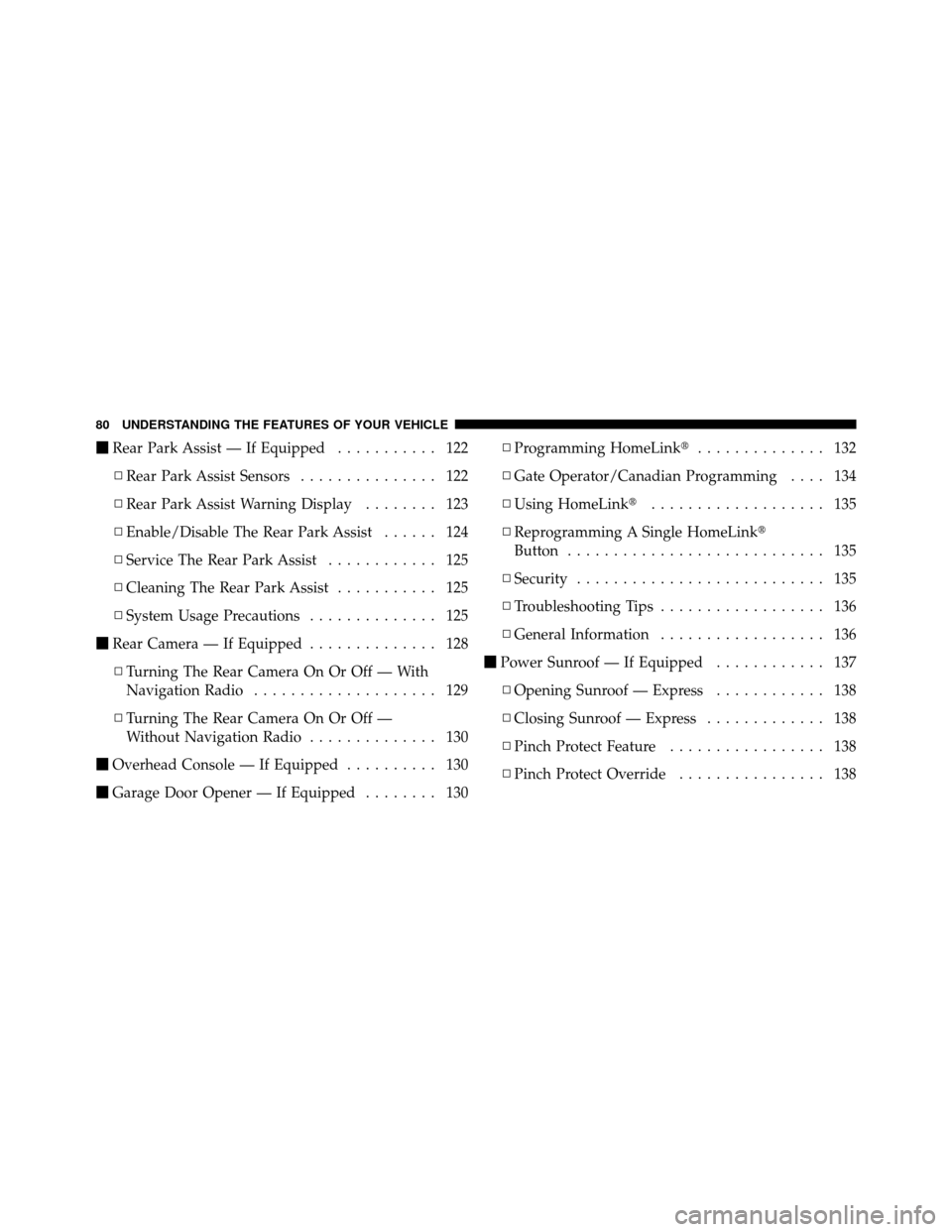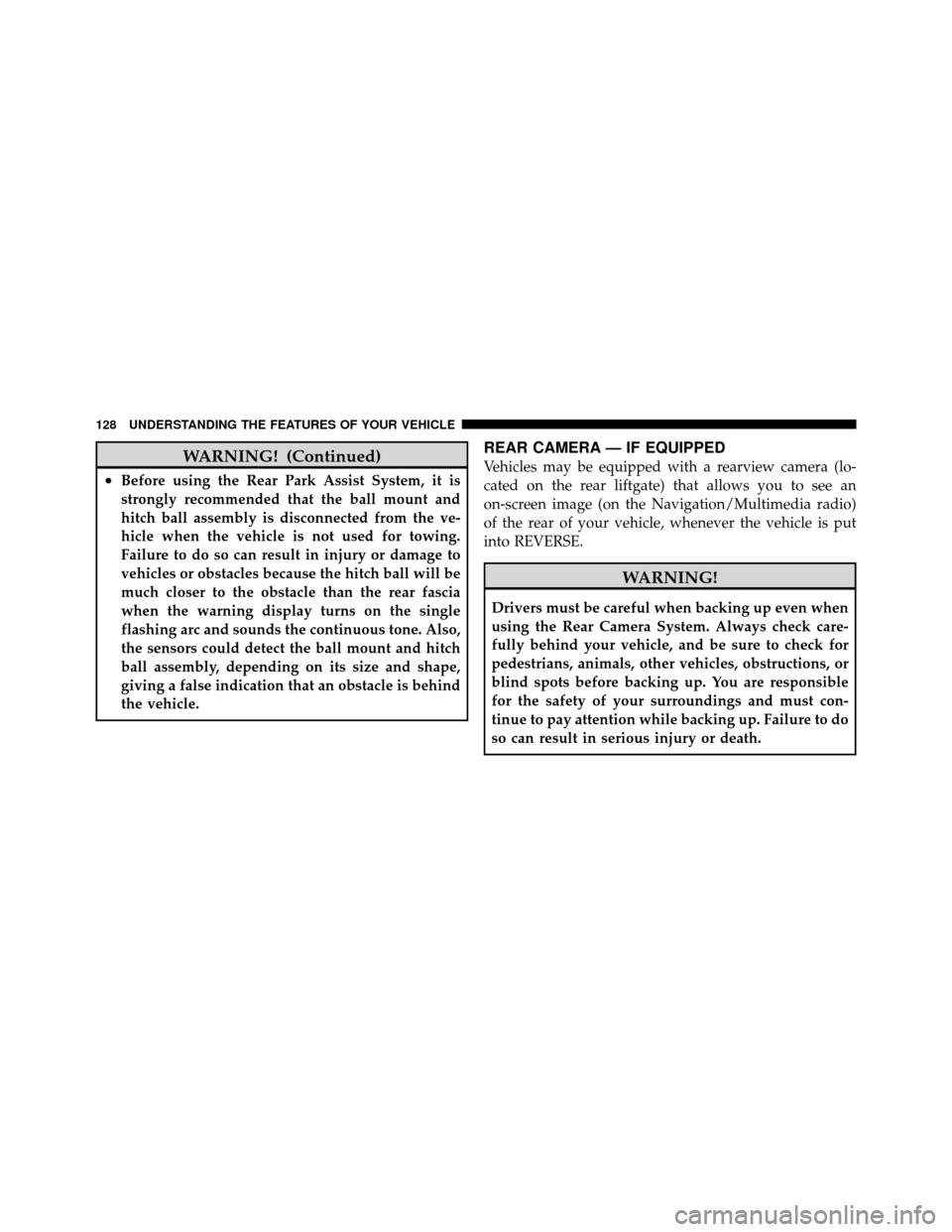Page 80 of 460

�Rear Park Assist — If Equipped ........... 122
▫ Rear Park Assist Sensors ............... 122
▫ Rear Park Assist Warning Display ........ 123
▫ Enable/Disable The Rear Park Assist ...... 124
▫ Service The Rear Park Assist ............ 125
▫ Cleaning The Rear Park Assist ........... 125
▫ System Usage Precautions .............. 125
� Rear Camera — If Equipped .............. 128
▫ Turning The Rear Camera On Or Off — With
Navigation Radio .................... 129
▫ Turning The Rear Camera On Or Off —
Without Navigation Radio .............. 130
� Overhead Console — If Equipped .......... 130
� Garage Door Opener — If Equipped ........ 130▫
Programming HomeLink� .............. 132
▫ Gate Operator/Canadian Programming .... 134
▫ Using HomeLink� ................... 135
▫ Reprogramming A Single HomeLink�
Button ............................ 135
▫ Security ........................... 135
▫ Troubleshooting Tips .................. 136
▫ General Information .................. 136
� Power Sunroof — If Equipped ............ 137
▫ Opening Sunroof — Express ............ 138
▫ Closing Sunroof — Express ............. 138
▫ Pinch Protect Feature ................. 138
▫ Pinch Protect Override ................ 138
80 UNDERSTANDING THE FEATURES OF YOUR VEHICLE
Page 122 of 460

NOTE:
•The Electronic Speed Control System maintains speed
up and down hills. A slight speed change on moderate
hills is normal.
•On steep hills a greater speed loss or gain may occur so
it may be preferable to drive without Electronic Speed
Control.
REAR PARK ASSIST — IF EQUIPPED
The Rear Park Assist provides visible and audible indi-
cations of the distance between the rear fascia and the
detected obstacle when backing up. Refer to the Warning
Section and Note Section for limitations of this system
and recommendations.
The Rear Park Assist will remember the last system state
(enabled or disabled) from the last ignition cycle when
the ignition is changed to the ON position.The Rear Park Assist can be active only when the shift
lever is in REVERSE. If the Rear Park Assist is enabled at
this shift lever position, the system will be active until the
vehicle speed is increased to approximately 11 mph
(18 km/h) or above. The system will be active again if the
vehicle speed is decreased to speeds less than approxi-
mately 10 mph (16 km/h).
Rear Park Assist Sensors
The four Rear Park Assist Sensors, located in the rear
fascia, monitor the area behind the vehicle that is within
the sensors’ field of view.
The sensors can detect obstacles from approximately 12
to 59 in (30 to 150 cm) from the rear fascia in the
horizontal direction, depending on the location and
orientation of the obstacle and the type of obstacle.
122 UNDERSTANDING THE FEATURES OF YOUR VEHICLE
Page 125 of 460

When the switch is pressed to disable the system, the
instrument cluster will display the “PARK ASSIST DIS-
ABLED” message. Refer to “Electronic Vehicle Informa-
tion Center (EVIC)” in Section 4 of this manual. When the
shift lever is changed to REVERSE and the system is
disabled, the instrument cluster will actuate a single
chime, once per ignition cycle, and it will display the
message.
The Rear Park Assist Switch LED will be ON when the
Rear Park Assist is disabled or defective. The Rear Park
Assist Switch LED will be OFF when the system is
enabled.
Service The Rear Park Assist
When the Rear Park Assist is defective, the instrument
cluster will actuate a single chime, once per ignition
cycle, and it will display the “SERVICE PARK ASSIST
SYSTEM” message. Refer to “Electronic Vehicle Informa-
tion Center (EVIC)” in Section 4 of this manual. If“SERVICE PARK ASSIST SYSTEM” appears in the EVIC
after making sure the rear fascia/bumper is clean and
free of snow, ice, mud, or other debris, see your autho-
rized dealer.
Cleaning The Rear Park Assist
Clean the Rear Park Assist Sensors with water, car wash
soap and a soft cloth. Do not use rough or hard cloths. Do
not scratch or poke the sensors. Otherwise, you could
damage the sensors.
System Usage Precautions
NOTE:
•Ensure that the rear bumper is free of dirt and debris
to keep the Rear Park Assist System operating prop-
erly.
•Jackhammers, large trucks, and other vibrations could
affect the performance of the Rear Park Assist System.
3
UNDERSTANDING THE FEATURES OF YOUR VEHICLE 125
Page 126 of 460

•When you turn off the Rear Park Assist System, the
instrument cluster will display “PARK ASSIST DIS-
ABLED.” Furthermore, once you turn off the Rear
Park Assist System, it remains off until you turn it on
again, even if you cycle the ignition key.
•When you move the shift lever to the REVERSE
position and the Rear Park Assist System is turned off,
the instrument cluster will display “PARK ASSIST
DISABLED” message for as long as the vehicle is in
REVERSE.
•The Rear Park Assist System, when on, will MUTE the
radio when it is sounding a tone.
•If a Rear Park Assist System malfunction occurs, a
single chime will sound once per ignition cycle. In
addition, the Electronic Vehicle Information Center(EVIC) will display “SERVICE PARK ASSIST SYS-
TEM”. If this occurs making sure the rear fascia/
bumper is free from snow, ice, mud, dirt and debris,
see your authorized dealer.
•Clean the Rear Park Assist Sensors regularly, taking
care not to scratch or damage them. The sensors must
not be covered with ice, snow, slush, mud, dirt, or
debris. Failure to do so can result in the system not
working properly. The system might not detect an
obstacle behind the fascia/bumper, or it could provide
a false indication that an obstacle is behind the fascia/
bumper.
•Objects must not be within 12 in (30 cm) from the rear
fascia/bumper while driving the vehicle. Failure to do
so can result in the system misinterpreting a close
object as a sensor problem, causing the “SERVICE
PARK ASSIST SYSTEM” message to be displayed in
the instrument cluster.
126 UNDERSTANDING THE FEATURES OF YOUR VEHICLE
Page 127 of 460

CAUTION!
•The Rear Park Assist System is only a parking aid
and it is unable to recognize every obstacle, in-
cluding small obstacles. Parking curbs might be
temporarily detected or not detected at all. Ob-
stacles located above or below the sensors will not
be detected when they are in close proximity.
•The vehicle must be driven slowly when using the
Rear Park Assist System to be able to stop in time
when the obstacle is detected. It is recommended
that the driver looks over his/her shoulder when
using the Rear Park Assist System.
WARNING!
•Drivers must be careful when backing up even
when using the Rear Park Assist System. Always
check carefully behind your vehicle, look behind
you, and be sure to check for pedestrians, animals,
other vehicles, obstructions, and blind spots be-
fore backing up. You are responsible for safety and
must continue to pay attention to your surround-
ings. Failure to do so can result in serious injury or
death.(Continued)
3
UNDERSTANDING THE FEATURES OF YOUR VEHICLE 127
Page 128 of 460

WARNING! (Continued)
•Before using the Rear Park Assist System, it is
strongly recommended that the ball mount and
hitch ball assembly is disconnected from the ve-
hicle when the vehicle is not used for towing.
Failure to do so can result in injury or damage to
vehicles or obstacles because the hitch ball will be
much closer to the obstacle than the rear fascia
when the warning display turns on the single
flashing arc and sounds the continuous tone. Also,
the sensors could detect the ball mount and hitch
ball assembly, depending on its size and shape,
giving a false indication that an obstacle is behind
the vehicle.
REAR CAMERA — IF EQUIPPED
Vehicles may be equipped with a rearview camera (lo-
cated on the rear liftgate) that allows you to see an
on-screen image (on the Navigation/Multimedia radio)
of the rear of your vehicle, whenever the vehicle is put
into REVERSE.
WARNING!
Drivers must be careful when backing up even when
using the Rear Camera System. Always check care-
fully behind your vehicle, and be sure to check for
pedestrians, animals, other vehicles, obstructions, or
blind spots before backing up. You are responsible
for the safety of your surroundings and must con-
tinue to pay attention while backing up. Failure to do
so can result in serious injury or death.
128 UNDERSTANDING THE FEATURES OF YOUR VEHICLE
Page 166 of 460

CAUTION!
The TPMS has been optimized for the original
equipment tires and wheels. TPMS pressures and
warning have been established for the tire size
equipped on your vehicle. Undesirable system opera-
tion or sensor damage may result when using re-
placement equipment that is not of the same size,
type, and/or style. Aftermarket wheels can cause
sensor damage. Do not use tire sealant from a can, or
balance beads if your vehicle is equipped with a
TPMS, as damage to the sensors may result.
13. Temperature Gauge
The temperature gauge shows engine coolant tempera-
ture. Any reading within the normal range indicates that
the engine cooling system is operating satisfactorily. The gauge pointer will likely indicate a higher tempera-
ture when driving in hot weather, up mountain grades,
or when towing a trailer. It should not be allowed to
exceed the upper limits of the normal operating range.
CAUTION!
Driving with a hot engine cooling system could
damage your vehicle. If temperature gauge reads “H”
pull over and stop the vehicle. Idle the vehicle with
the air conditioner turned off until the pointer drops
back into the normal range. If the pointer remains on
the “H” and you hear continuous chimes, turn the
engine off immediately, and call an authorized deal-
ership for service.
166 UNDERSTANDING YOUR INSTRUMENT PANEL
Page 180 of 460

5. Complete one or more 360–degree turns (in an area
free from large metal or metallic objects) until the “CAL”
indicator turns off. The compass will now function
normally.
Compass Variance
Compass Variance is the difference between Magnetic
North and Geographic North. To compensate for the
differences, the variance should be set for the zone where
the vehicle is driven, per the zone map. Once properly
set, the compass will automatically compensate for the
differences, and provide the most accurate compass
heading. For the most accurate compass performance, the
compass must be set using the following steps.
NOTE:Magnetic materials should be kept away from
the overhead console or center of the headliner. This is
where the compass sensor is located. 1. Turn the ignition switch ON.
2. Press the MENU button until Personal Settings
(Customer-Programmable Features) menu is reached.
3. Press the SCROLL button until “Compass Variance” is
displayed in the EVIC.
Compass Variance Map
180 UNDERSTANDING YOUR INSTRUMENT PANEL